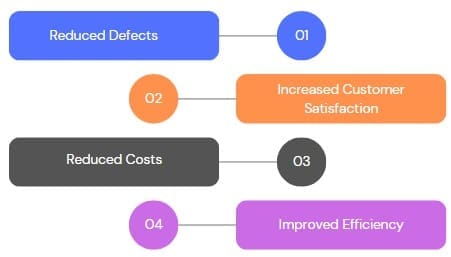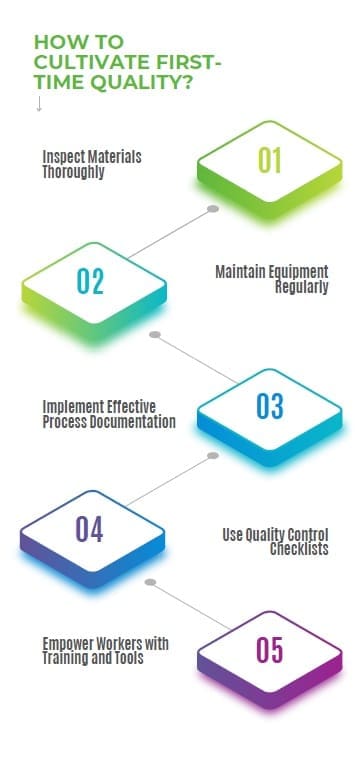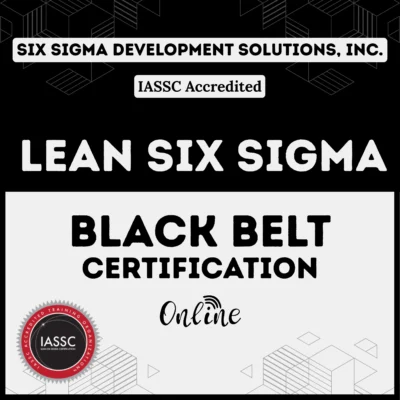First Time Quality (FTQ), also known as First Time Right, is a critical concept in manufacturing and production. It focuses on creating products that meet quality standards on the first attempt. This approach aims to minimize defects and reduce waste by producing usable goods from the start of production.
FTQ is often measured as a percentage of items that meet quality requirements without requiring rework or adjustments.
The ultimate goal of FTQ is to produce goods that are free of defects. This not only improves product quality but also boosts overall efficiency. FTQ is linked to methodologies like Six Sigma, which emphasizes reducing errors and waste. By implementing FTQ, manufacturers can optimize their processes and improve their output.
Table of contents
What is First Time Quality?
First Time Quality (FTQ) aims to produce goods that meet quality standards on the first attempt. It measures the percentage of products or services that are made correctly without requiring any rework, adjustments, or corrections after the initial production.
The goal is to eliminate defects from the beginning of the production process, reducing waste, saving time, and ensuring that products are ready for customers right away.
In simpler terms, FTQ means getting things right the first time, so there’s no need to redo work or scrap defective products. This approach not only improves the overall quality of the product but also boosts efficiency and reduces costs associated with fixing mistakes or throwing away defective items.
FTQ plays an important role in quality management and links directly to methodologies like Six Sigma, which focuses on reducing errors and improving processes. By implementing FTQ, companies can create higher-quality products, increase customer satisfaction, and achieve better operational performance.
First Time Quality in Manufacturing
In manufacturing, FTQ refers to the ratio of good products produced in the initial production run. If 1,000 units are produced, and 950 meet quality standards, the FTQ is 95%. The remaining 5% are considered defective or scrap.
FTQ measures both process input and output. It helps identify the efficiency of the production process and how often mistakes are made. An important component of FTQ is continuous improvement. When the percentage of quality products on the first try increases, manufacturers can focus on refining their processes further.
Importance of FTQ
FTQ plays a crucial role in increasing efficiency and reducing costs. When products are produced correctly the first time, there is less need for corrections, rework, or disposal. This leads to a significant reduction in waste. By ensuring that fewer products are defective, FTQ also improves the bottom line for businesses.
By adopting FTQ, manufacturers aim to:
- Improve product quality
- Minimize the cost of defects and waste
- Increase production efficiency
Benefits of First-Time Quality

- Reduced Defects: FTQ helps identify defects early in the process, preventing costly mistakes later on.
- Increased Customer Satisfaction: Products that meet high-quality standards on the first attempt are more likely to satisfy customers.
- Reduced Costs: Less rework and fewer defective products lead to lower production costs.
- Improved Efficiency: FTQ drives a culture of continuous improvement, boosting overall productivity.
Steps to Achieve FTQ

FTQ relies on the DMAIC methodology, a five-step process often used in Six Sigma to ensure quality improvement. These steps include:
- Define: Identify the issues with the current process that lead to defects.
- Measure: Quantify the impact of defects and determine how often they occur.
- Analyze: Investigate the root causes of the defects in the production process.
- Improve: Implement changes that address the identified issues.
- Control: Monitor the process continuously to maintain improvements and prevent future defects.
By following this structured approach, manufacturers can continuously improve their FTQ and reduce defects over time.
How to Cultivate First-Time Quality?

Achieving FTQ requires strategic actions and attention to several key areas. Here are some essential tips for improving FTQ in manufacturing:
Inspect Materials Thoroughly
The quality of raw materials is a significant factor in the final product’s quality. Materials that don’t meet quality standards can cause defects in the final product. Inspect materials before they enter the production line. Work closely with suppliers to ensure that they provide defect-free materials. This step helps prevent product flaws caused by poor-quality inputs.
Maintain Equipment Regularly
Machine malfunctions can often lead to defective products. It is essential to maintain production equipment regularly. Over time, machines may lose precision, causing defects in the finished products. Scheduling routine inspections and repairs ensures that machinery is working optimally. This reduces downtime and prevents product defects.
Implement Effective Process Documentation
Proper documentation of all production processes is critical for FTQ. Detailed records ensure that every step in the process stays consistent. When personnel change or a new worker is trained, clear documentation keeps the process the same. By following standardized procedures, workers are less likely to make mistakes that result in defective products.
Use Quality Control Checklists
A quality control checklist helps standardize and optimize quality assurance processes. By following a checklist, employees ensure that they perform every step of the process correctly. This minimizes the chance of defects caused by human error. Consistent use of checklists can lead to higher first-time quality.
Empower Workers with Training and Tools
To improve FTQ, it’s vital to invest in worker training. Workers need to understand the quality standards and how to meet them. Providing workers with the right tools and technology can also help. Using digital tools to track and improve quality control procedures can eliminate inconsistencies and improve FTQ.
Role of Technology in Achieving FTQ
New technologies, such as AI-powered tools and connected worker solutions, can play a significant role in improving FTQ. These tools allow manufacturers to monitor production in real time. They also provide insights into where defects are occurring, helping manufacturers address problems quickly.
By leveraging technology, manufacturers can increase their chances of producing goods that meet quality standards on the first attempt.
For example, Augmentir, a connected worker solution, helps organizations digitize production processes. These technologies ensure that quality standards are met consistently, reducing defects and improving FTQ.
Measuring and Improving FTQ
To accurately measure FTQ, companies must first establish clear quality metrics. These metrics will serve as benchmarks for evaluating performance. After each production run, the team calculates FTQ by dividing the number of defect-free items by the total number of items produced.
Once the team measures FTQ, they can identify areas of the production process that need improvement. For instance, if a certain step in the process leads to a higher rate of defects, they can analyze and optimize it. By continuously measuring FTQ and implementing improvements, manufacturers can increase their production efficiency over time.
Connection Between FTQ and Total Quality Management
FTQ is an integral part of Total Quality Management (TQM). TQM is a business philosophy that emphasizes continuous improvement and customer satisfaction.
FTQ is one method used in TQM to ensure that products meet customer expectations from the start. By focusing on FTQ, organizations can align their processes with TQM principles, creating a culture of quality across all departments.
The primary principles of TQM include:
- A customer-focused approach
- Total employee involvement
- A process-centered approach
- Integrated strategies for quality improvement
By applying FTQ principles within a TQM framework, businesses can ensure that their products are consistently defect-free and meet customer needs.
Common Challenges in Achieving FTQ

While FTQ offers many benefits, there are challenges that manufacturers may face when trying to implement it. Some of the common obstacles include:
Lack of proper training: Workers who are not adequately trained may not understand the quality standards, leading to defects.
Inconsistent materials: Poor-quality raw materials can result in defective products, even if the production process is flawless.
Equipment failure: Malfunctioning machinery can cause errors in the production process, affecting FTQ.
Resistance to change: Some employees may resist changes in production methods or quality standards, hindering FTQ improvements.
Final Words
First Time Quality (FTQ) is a critical strategy for improving manufacturing efficiency and reducing waste. By focusing on producing defect-free products from the start, manufacturers can enhance customer satisfaction, cut costs, and streamline their production processes.
FTQ is supported by methodologies like Six Sigma and is implemented through the DMAIC framework. Companies can improve FTQ by ensuring high-quality materials, maintaining equipment, documenting processes, and investing in technology.
Incorporating FTQ into a broader Total Quality Management (TQM) approach aligns all aspects of the organization toward delivering high-quality products. With continuous monitoring and improvement, FTQ can help.


















